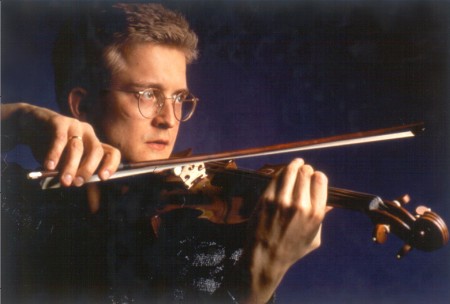Classical Music Review: Christian Tetzlaff All Alone
There is no doubt that Christian Tetzlaff stands among the very top rank of today’s violinists.

Violinist Christian Tetzlaff—His was fiddling on an amazing level that few others could match.
Reviewed By Caldwell Titcomb
It’s not often that one enters Jordan Hall and sees a completely empty stage—no chair, no piano, no music stand. But all that was needed was a bare floor to accommodate the 43-year-old, German violinist Christian Tetzlaff, who offered a Celebrity Series concert of music for unaccompanied violin on January 31.
Tetzlaff wasted no time in a warm-up piece and delved at once into J.S. Bach, whose half dozen unaccompanied partitas and sonatas stand at the very top of the genre. He chose to begin with the Partita No. 2 in D-minor (BWV 1004), followed by the Sonata No. 3 in C-major (BWV 1005).
The Partita has the usual four movements found in a suite: allemande, courante, sarabande, and gigue. But then Bach added a fifth movement—the most celebrated movement in the entire set—a chaconne. This is a series of continuous variations based on a constant harmonic theme in moderately slow triple meter. It is a huge piece, lasting 13 minutes—almost as long as the previous four movements combined. The player conveys the harmony by sounding more than one string at once, sometimes all four nearly together.
The Sonata is cast in the customary slow-fast-slow-fast sequence. But the second movement is a long fugue (based on a Lutheran chorale). Here the single instrument must capture the complex interplay of several polyphonic lines simultaneously. In writing these works, Bach—like other late-Baroque composers, architects, and painters—was attempting the impossible.
I was following the score in these two performances, and Tetzlaff did not miss a single note. This was fiddling on an amazing level that few others could match. There was no harshness, and he shaped phrases with subtle rubato. He has lived with these works a long time and has recorded the whole set of six compositions more than once.
After intermission he turned to the contemporary, Hungarian composer György Kurtág (b. 1926), playing four brief miniatures mostly from a set of “Signs, Games, and Messages,” of which the last was strikingly brutal.

Christian Tetzlaff
An important musician who paid homage to Bach was Eugène Ysaÿe (1858-1931), who was the father of modern fiddling and a strong influence on later virtuosi such as Fritz Kreisler, Jacques Thibaud, Georges Enesco, and Joseph Szigeti. Like Bach, he wrote six works for unaccompanied violin (published as Op. 27 in 1924). From these Tetzlaff chose No. 1 in G-minor and found more in its four movements than do most violinists. The first movement requires the bow to produce glassy tremolos by playing at the bridge. Like Bach’s C-major, the second movement employs a fugal texture.
Tetzlaff concluded with music by Nicolò Paganini (1782-1840), probably the most famous violinist of all time. Over a period of some years, he composed a series of 24 caprices, which he published in 1820 as Op. 1. These are works of inordinate technical difficulty. Tetzlaff chose four of them: No. 16 in G-minor; No. 6 in G-minor, which exploits trills; No. 15 in E-minor, which bears the unusual marking “posato” (sedate, staid); and No. 1 in E-major, which features arpeggios. Tetzlaff made these look easy—they aren’t.
As encores, he played the charming E-major Gavotte from Bach’s Partita No. 3 (BWV 1006) and one more Kurtág miniature. There is no doubt that Tetzlaff stands among the very top rank of today’s violinists.
Tagged: Caldwell-Titcomb, Celebrity-Series, Christian Tetzlaff
